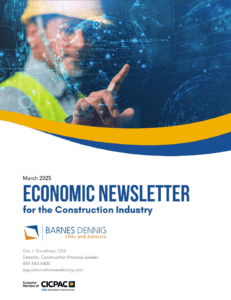CICPAC Weighs In | Construction Industry Economic Outlook
Published on by Portia Kohls in Construction

As the construction industry faces another year of shifting momentum, the latest 2025 CICPAC Economic Newsletter offers critical insights into the forces reshaping the field. From tariff-driven cost volatility and inflationary pressure to workforce shortages and historic legislative incentives, this quarter’s report captures a sector navigating immediate challenges while preparing for a wave of long-term investment.
This summary distills key takeaways from the report to help you stay ahead in a dynamic and increasingly competitive environment.
Topline takeaways from this quarter’s report
The U.S. economy continues to move through cycles of instability. After a soft Q1, GDP rebounded to 2.4% in Q2, but Q3 projections are trending downward, potentially dipping below 1.3%. A surge in imports early in the year inflated inventories, but persistent tariff uncertainty and weaker consumer confidence are dragging on business investment and project execution.
Inflation, which had been retreating in prior quarters, is now back on the rise, reaching 2.7% and expected to approach 3.5% by year-end. The Fed has paused rate changes in 2025 so far, but quarter-point cuts are anticipated in September and December, dependent on inflation behavior.

Non-residential stays strong
Within the construction sector, non-residential activity remains a pillar of strength, especially in manufacturing, energy, and infrastructure. While year-over-year spending is down 1.1%, levels remain ~25% above pre-pandemic norms. The passage of the One Big Beautiful Bill Act (OBBBA), which includes 100% bonus depreciation for industrial construction started before 2029, could generate $5–$8 trillion in new investment over the next five years. Shovel-ready projects in 2026–2027 will be critical.
Residential – not so much
In contrast, residential construction continues to slow, with activity down 6.7% year-over-year and home inventories swelling to 9.8 months – the highest since 2007. High interest rates and affordability concerns remain a drag, although multi-family and custom home sectors show pockets of resilience. Permitting has been mixed, with multifamily permits outperforming single-family.
Top challenges facing the construction industry
Material pricing volatility remains a key concern. Tariffs on steel and aluminum have climbed to 50%, with copper expected to follow. While global demand is soft, tariffs and supply chain restructuring are creating new layers of complexity for contractors and procurement teams. Inventories built up earlier this year are beginning to run low, and Q3 could bring renewed price pressure.
Labor shortages remain a top challenge. Despite 7.7 million open jobs nationally, the majority of unemployed workers lack the skills required for construction roles. The Employment Cost Index rose 2.9% for the sector, driven by increasing competition for experienced tradespeople. This issue is expected to intensify as more Baby Boomers reach retirement age by 2030.
Credit conditions remain tight, with 18.5% of large and mid-sized commercial firms facing stricter lending standards. However, optimism is building that legislation like OBBBA could lead to looser credit conditions in Q4 and beyond. In contrast, the ABA Credit Conditions Index dipped again in Q2, signaling continued caution from banks in the short term.
Strong markets
Regionally, markets like Dallas-Fort Worth, Houston, New York, and Salt Lake City continue to show high construction potential, according to CICPAC’s metro index. The Southeast and Southwest are home to many of the fastest-growing metros by construction GDP.
For deeper insights, regional data, and sector-by-sector analysis, download the full July 2025 Construction Industry Economic Newsletter. Looking for tailored insights on how this report might affect your strategy? Contact our Construction Services team today to schedule a no-cost consultation. As always, our top construction industry pros are here to help.
